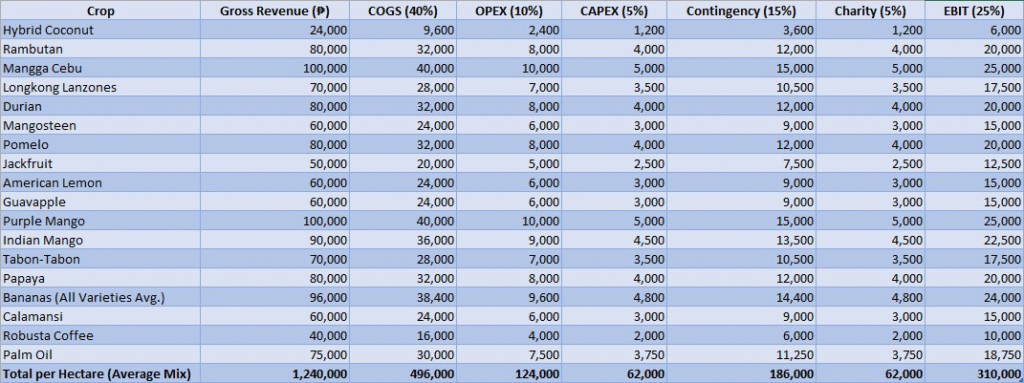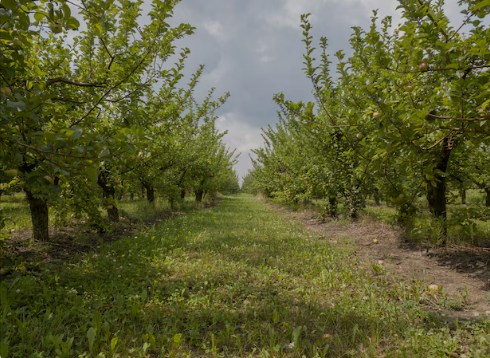How to Grow and Nurture Fruit Trees
Building a Profitable Agroforestry System in Bukidnon: Growing and Nurturing Fruit Trees Beneath Our Hybrid Coconuts
At Jessie’s Sunshine Farm in the southern heart of Bukidnon, the fertile highland soils and steady tropical rains give us a rare opportunity to create something more than a typical plantation. Our vision is to cultivate a diverse and sustainable agroforestry ecosystem, where our hybrid coconuts form the protective canopy and an array of fruit trees thrive beneath—forming the second and some even in a third layers of productivity. This design not only optimizes land use across our six hectares but also builds resilience, biodiversity, and long-term income stability for generations to come.
Diversity as the Key to Sustainable Growth
Our farm integrates a rich mix of fruit-bearing trees: Rambutan, Mangga Cebu, Longkong Lanzones, Durian, Mangosteen, Pomelo, Jackfruit, American Lemon, Guavapple, Sweet Guyabano, Bangkok Suntal, Purple Mango, Indian Mango, Tabon-Tabon, and Papaya. Interspersed among the coconut rows are Lakatan, Latundan, Saba, Tinduk bananas, Calamansi, and Robusta Coffee, forming the lower layers between the coconut lines.

Tabon Tabon
Each species plays a role. Hence, coconuts provide steady, year-round shade and a tall canopy that moderates soil temperature and wind exposure. Consequently, beneath them, the fruit trees develop strong roots and broad crowns that add diversity to the soil microbiome. The bananas, papayas, and coffee occupy the midlines and ground levels, maximizing every square meter of sunlight that filters through the palms.
Work and Nurturing: Cultivating the Orchard Layer
Our farm operations revolve around continuous care and observation. Each fruit tree has its own rhythm of growth, and nurturing them means understanding these rhythms.
In the early years, our team focuses on site preparation and soil conditioning. Deep holes are dug and refilled with composted coconut husks, cuttings of grass, chicken manure, and natural lime to balance acidity. For the first two years, weeding is a critical task—both manual and mulched—to protect young trees from competition. Intercropped banana plants provide quick shade, organic mulch, and early income while the slower-growing durian, mangosteen, and Lanzones mature.
Pruning is conducted twice yearly to balance growth and encourage fruiting. Coconut leaves are trimmed to allow filtered light, while fruit trees are shaped depending on their species—mangoes in a vase form, citrus in open centers, and rambutan with balanced lateral branches. Proper pruning ensures sunlight penetration, reduces pest pressure, and facilitates harvesting.
Fertilization follows an integrated system. Organic compost is combined with targeted NPK applications and micronutrients. We use banana plant and grass cuttings, and also all sort of organic matter to enhance soil vitality. Regular soil testing allows us to adjust nutrients based on species needs—Durian and Lanzones, for example, are more sensitive to calcium and magnesium deficiencies common in volcanic soils.


Managing Pests and Weather Challenges
Mindanao’s humid conditions bring seasonal pests—fruit borers, mealybugs, and fungal spots. We mitigate these naturally, using Neem and Kakawate leaf sprays, beneficial insects, and proper airflow from pruning. Drainage ditches and contouring prevent flooding during Bukidnon’s heavy rains, while mulch layers conserve moisture in the drier months.
Harvest and Distribution: Turning Fruits into Revenue
Harvesting is timed carefully, depending on species maturity and market demand. Rambutan and Lanzones peak from August to November, while durian, mangosteen, and pomelo ripen in staggered cycles. Mango and Guyabano harvests fill the summer months, while bananas and coconuts provide continuous supply throughout the year.

After harvest, produce is sorted, graded, and prepared for delivery to local markets in Don Carlos, Kibawe, Kadingilan, and Maramag. These towns form the core of our regional distribution network, with direct-to-market supply chains for fresh fruit vendors, wholesalers, and food processors. Our long-term goal is to build partnerships with trading corporations and Mindanao-based agribusiness exporters, ensuring consistent demand and fair pricing for our diverse produce.
Establishing the Marketing and Trade Network
While the trees are still growing into full production, we are simultaneously laying the foundation of a regional trading network. Our strategy includes building relationships with municipal agricultural offices, local cooperatives, and private buyers. Eventually, the plan is to consolidate harvests into branded produce shipments—“Jessie’s Sunshine Fruits”—highlighting quality, traceability, and sustainable farming origins. This branding will not only increase our profitability but also open doors to supermarkets and institutional buyers across Northern Mindanao.
Challenges and the Path Forward
Mindanao’s humid conditions bring seasonal pests—fruit borers, mealybugs, and fungal spots. We mitigate these naturally, using Neem and Kakawate leaf sprays, beneficial insects, and proper airflow from pruning. Drainage ditches and contouring prevent flooding during Bukidnon’s heavy rains, while mulch layers conserve moisture in the drier months.
Agroforestry is not an easy path. It demands patience, capital, and labor discipline. The diversity of species means managing different nutrient needs, pruning schedules, and pest cycles. Weather unpredictability can cause irregular harvests. Yet, with the steady foundation of coconuts and the progressive inclusion of intercropped fruits, the farm develops multiple streams of income—making it resilient against market and climate fluctuations.
Financial Summary and Profitability Outlook (80% Conservative Estimate)
To project sustainable revenue, we use 80% of ideal farmgate prices per tree or per hectare, reflecting conservative, real-world conditions in Bukidnon.
🧾 Interpretation & Outlook
At 80% of ideal market prices, Jessie’s Sunshine Farm maintains an expected annual EBIT of ₱X.XX million at full maturity (Year 6–7).
This structure allows for:
- Sustainable reinvestment through a 5% CAPEX reserve for new seedlings and farm upgrades.
- Risk protection via a 15% contingency fund, critical for climate or market disruptions.
- Consistent 5% allocation for charity, supporting community projects and workers’ families.
- Strong profitability with diversified income sources spread across multiple harvest periods.
By combining high-value fruits like durian, mango, and rambutan with steady yielders like coconuts, bananas, and papaya, the farm achieves year-round revenue flow and long-term financial security.

🌱 Strategic Insights for Bukidnon Conditions
- Soil Fertility: Volcanic soils favor the deep-feeding roots of coconut, mango, and durian. Regular organic compost (1–2 tons/ha annually) sustains nutrient balance.
- Rainfall & Drainage: High rainfall zones require grass strips and contour weeding to prevent erosion and root rot.
- Tree Spacing: Dual canopy design — coconuts (main crop) spaced at 9 m between coconut trees, with intercrops (rambutan, mango, lanzones, etc.) in alternate rows — maximizes sunlight capture.
- Bananas & Papaya: Early income crops bridge cash flow until tree fruits reach maturity.
- Post-Harvest & Market Chain:
- Establish village-level consolidation points for bulk handling and grading.
- Link to Maramag and Valencia trading hubs for consistent farmgate movement.
- Explore co-branding with regional distributors for premium fruit labeling.
For further reading visit here
A Sustainable and Faith-Guided Vision
The success of Jessie’s Sunshine Farm is not measured only in pesos, but in purpose. Each harvest strengthens our community, supports families, and honors the Lord who gives growth and abundance. Through patience, good stewardship, and sound management, our Bukidnon agroforestry model aims to become a living example of profitable, faith-based sustainability in Mindanao, where nature and livelihood work together.
Matthew 7, NIV
Judging Others
1“Do not judge, or you too will be judged. 2 For in the same way you judge others, you will be judged, and with the measure you use, it will be measured to you.
3 “Why do you look at the speck of sawdust in your brother’s eye and pay no attention to the plank in your own eye? 4 How can you say to your brother, ‘Let me take the speck out of your eye,’ when all the time there is a plank in your own eye?
5 You hypocrite, first take the plank out of your own eye, and then you will see clearly to remove the speck from your brother’s eye. 6 “Do not give dogs what is sacred; do not throw your pearls to pigs. If you do, they may trample them under their feet, and turn and tear you to pieces.
